
Original Link: https://www.anandtech.com/show/6984/thermaltake-water-30-closed-loop-cooler-roundup
Thermaltake Water 3.0 Closed Loop Cooler Roundup
by Dustin Sklavos on May 31, 2013 12:01 AM EST- Posted in
- Cases/Cooling/PSUs
- Thermaltake
- Water Cooling
_678x452.jpg)
Introducing the Thermaltake Water 3.0 Family
The Water 3.0 revision of Thermaltake's closed loop cooling line is, in an interesting turn of events, an opportunity for us to essentially test the stock, traditional versions of Asetek's closed loop cooler products. Companies like Corsair, NZXT, and Thermaltake (among others) will often take the existing radiator, pump, and waterblock loop and give it their own spin, either by including special software, adding fan headers, or just using higher quality fans to differentiate their products. We've been able to test the CoolIT versions of the 120mm and 240mm radiator loops thanks to Corsair, but the Asetek ones are very popular as well (and in my opinion preferable), and thankfully that's what Thermaltake opted to go with for their third series of closed loop coolers.
| Water 3.0 Performer | Water 3.0 Pro | Water 3.0 Extreme | |
| Type | 120mm | 120mm | 240mm |
| Dimensions (in mm) | 151 x 120 x 27 | 151 x 120 x 49 | 270 x 120 x 27 |
| Fans (Supported) | 2 (2) | 2 (2) | 2 (4) |
| OEM | Asetek | Asetek | Asetek |
| MSRP (NewEgg) | $75 | $95 | $110 |
The variety of coolers is pretty simple: you're dealing with a traditional 120mm radiator in the Water 3.0 Pro, you get a double-thick 120mm radiator with the Water 3.0 Pro, and then you go back to standard thickness and double-length with the 240mm radiator in the Water 3.0 Extreme. What's unique to Thermaltake is that each of these coolers comes with two fans. Entry level kits typically only come with one fan (see Corsair's H60, NZXT's Kraken X40), but out of the box these should perform about as well as they can thermally.
As these are Asetek units, installation is handled using the same method I've detailed previously. Asetek uses a notched ring that's mounted through the mounting holes in the motherboard; from there, you line up the notches on the ring and the waterblock and slide it into place, then turn it so the notches on the ring lock the block. Twist the thumbscrews to secure the ring and you're done. It's very simple and as far as I'm concerned the easiest mounting system short of the one Cooler Master employs with their Seidon 240M.
.jpg)
It's important to remember, though, that the majority of these closed loop coolers employ aluminum fins in the radiator instead of copper and Thermaltake's is no different. A copper radiator like the one in Swiftech's H220 feels a lot heavier, but the fins themselves are also easier to bend due to the softer material. The copper also does a better job of dissipating heat; the 240mm H220 is essentially competitive with the 280mm NZXT Kraken X60 (itself an Asetek design).
Where Thermaltake diverges from the competition is that they opt to keep the packages as simple as possible. The Water 3.0 Extreme plugs into a USB 2.0 header on the motherboard and has the 4-pin PWM fan headers coming out of the block, and it benefits from software control essentially identical to what NZXT uses with the Kraken X40 and X60, suggesting even the software is a re-skinned OEM solution. That means three cooling modes: a "Silent" fan curve, an "Extreme" fan curve, and then a custom fan curve. Meanwhile, the 3.0 Pro and 3.0 Performer both rely on a PWM splitter connected to the CPU fan header on the motherboard to control fan speed; you'll need to plug the pump into a separate 3-pin header.
Testing Methodology
If you've been keeping up with our case reviews, our testing methodology for the fans here is going to seem relatively similar in some ways. Our test system may seem a bit unusual in more than a few ways, but stick with me and I'll explain why I put it together and tested it the way I did.
The processor, with its healthy voltage boost and overclock, throws a pretty substantial amount of heat at our cooling system. Testing with an i7-2700K at stock speeds would defeat the purpose; Intel's own stock cooler can handle that, we want to "separate the men from the boys" so to speak.
| Fan and Radiator Testing Configuration | |
| CPU | Intel Core i7-2700K overclocked to 4.4GHz @ 1.45V |
| Motherboard | Gigabyte GA-Z68MX-UD2H-B3 |
| Graphics | Intel HD 3000 IGP |
| Memory | 2x4GB Crucial Ballistix Sport Low Profile DDR3-1600 |
| Drives | Kingston SSDNow V+ 100 64GB SSD |
| Power Supply | Rosewill Hive 650W 80 Plus Bronze Modular |
| Enclosure | BitFenix Shinobi XL Window |
I needed a case that could produce adequate airflow, handle all of the different cooling systems without much trouble, and did not include any sound dampening features. You might be surprised at just how difficult that was to find, but BitFenix came to the rescue and sent over a Shinobi XL. BitFenix's enclosure didn't get the best review when I tested it, but it's actually ideal for this testbed. I removed every case fan but the front intake, which I ran at 5V to prevent it from affecting acoustics while still providing adequate airflow.
For air coolers, I added a Noctua 140mm rear exhaust fan and used the ultra low noise adaptor to ensure it didn't affect acoustics in any meaningful way. This is in line with the usage cases air coolers are designed for, and should be representative of the kind of airflow most users will have from their exhaust fan. After the last review I received complaints that because the exhaust fan wasn't included in testing closed loop coolers, the CLCs and air coolers couldn't be directly compared. Independently I tested and found that the fan's presence had absolutely no effect on CLC performance; CLCs essentially operate as their own exhausts, while air coolers need to have their exhaust directed outside of the case.
Since a dedicated GPU wasn't needed, one wasn't used. This prevents a graphics card from generating additional heat or noise or deflecting airflow.
Thermal and acoustic test cycles were done the same way as our case reviews. First, the system is left powered and idle for fifteen minutes. At this point the sound level is tested, room ambient temperature is recorded, and idle temperatures are recorded. Then eight threads of small FFTs in Prime95 are run for fifteen minutes, and load temperatures are recorded.
Each cooler was tested using its available presets; where presets weren't available, I tested using Gigabyte's standard motherboard PWM control as well as at 100%.
Thank You!
Before moving on, we'd like to thank the following vendors for providing us with the hardware used in our roundup.
- Thank you to iBuyPower for providing us with the Intel Core i7-2700K.
- Thank you to Gigabyte for providing us with the GA-Z68MX-UD2H-B3 motherboard.
- Thank you to Kingston for providing us with the SSDNow V+ 100 SSD.
- Thank you to Crucial for providing us with the Ballistix Sport Low Profile DDR3.
- Thank you to Rosewill for providing us with the Hive 650W 80 Plus Bronze PSU.
- Thank you to BitFenix for providing us with the Shinobi XL Window enclosure.
Primary Test Results
These cooling roundups produce a tremendous amount of raw data, so it pays to look at the results in specific context. The three Thermaltake Water 3.0 coolers can be used to get a general idea of how Asetek's more traditional CLCs perform as well, and their maximum cooling capacity can be ascertained when we take a look at the absolute performance results later on.
Initially we'll look at what I consider the most "balanced" results for each cooler we've tested so far; these results find the optimal balance between cooling performance and acoustics. Unfortunately, because the two 120mm Water 3.0 units use the motherboard's PWM control, fan speed gets ramped up under load and you'll see they become two of the loudest kits we've tested.
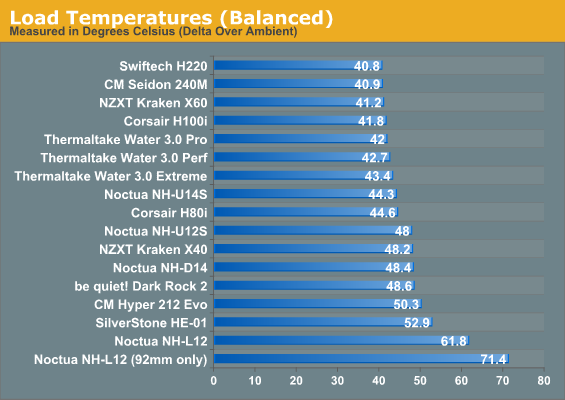
First, thermals. It may seem unusual that the Water 3.0 Extreme's 240mm radiator takes last place behind its siblings, but when you look at the noise levels it produces as a result of its more sophisticated fan control, you'll see why. The results overall are essentially competitive, though; between the CoolIT-based Corsair H80i and H100i and the Asetek-based Thermaltakes you'd be hard-pressed to find too much of a difference in overall thermal performance, or at least performance potential. We can narrow that down by looking at the CLC results specifically.
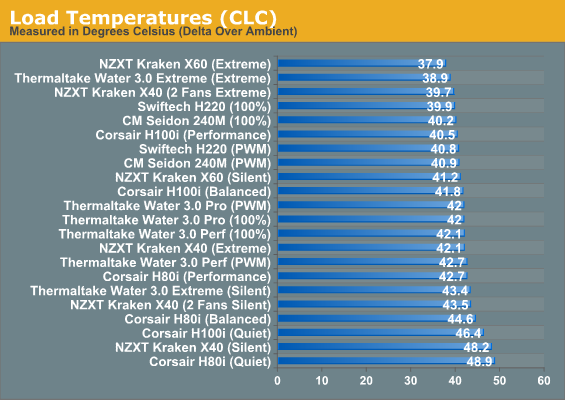
Cull the bottom three "quiet" results from Corsair and NZXT and you essentially look at only a roughly seven degree delta between the least powerful and most powerful closed loop coolers. In fact, going from a 240mm to a 280mm Asetek doesn't seem to yield much of a performance advantage. When we bring noise into the equation, though, the results separate a bit.
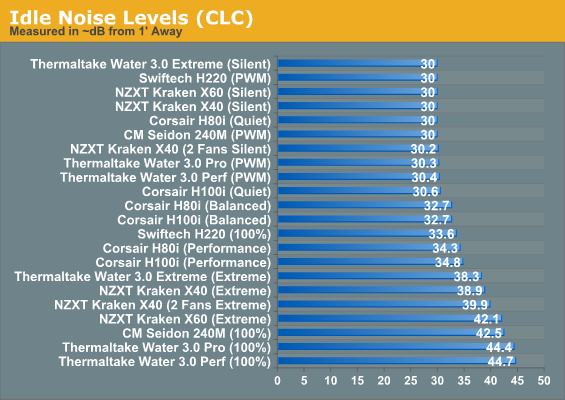
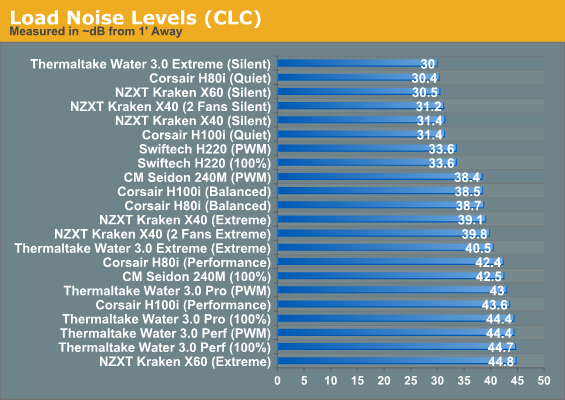
Load noise on the 120mm Water 3.0 entrants is frankly pretty nasty. The 240mm Water 3.0 Extreme on its Silent setting acquits itself reasonably well, but its performance is near the bottom of the pack. To me, this is where the closed loop coolers in general lose some of their appeal. Swiftech's H220 does a stellar job with its copper radiator and powerful pump, and it's really the odd man out due to its comparatively low load noise.
Silent Cooling Performance
Testing the Thermaltake Water 3.0 kits at their quietest reveals not just how important having a good fan control solution can really be, but also how important it is to pick good fans for your kit. The two 120mm kits do an absolutely horrible job of keeping noise down; they offer strong thermal performance, but the fans are extremely noisy in the process.
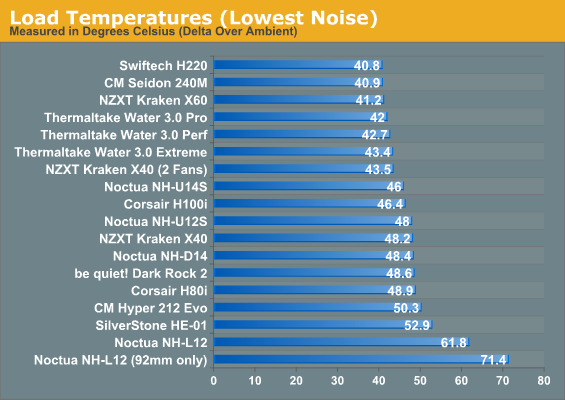
You can see for thermal performance they're near the top of the list, beating all of the air coolers. The problem is that, as you can see below, the air coolers are nowhere near as loud. Noctua's excellent NH-U14S is able to produce performance only 4C warmer at a staggering 14dB lower.
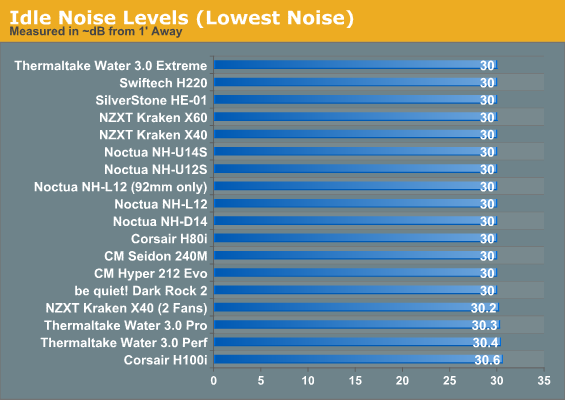
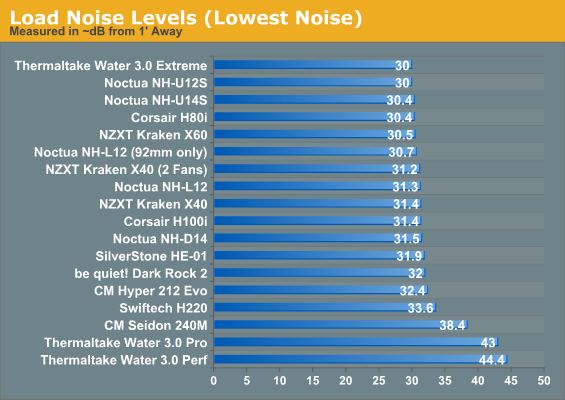
Balance is the name of the game, and our stress test forces the fans to eventually run full tilt. Only the Water 3.0 Extreme and its "Silent" fan control setting is able to keep the noise down. On balance, it looks like the best deal for quiet performance short of the Swiftech H220 or NZXT Kraken X60.
While I'm not a fan of absolute performance and prefer a more balanced approach to thermals and noise, I know my esteemed colleague, the good Dr. Ian Cutress will just run his cooling systems to the hilt to eke out as much performance as possible.
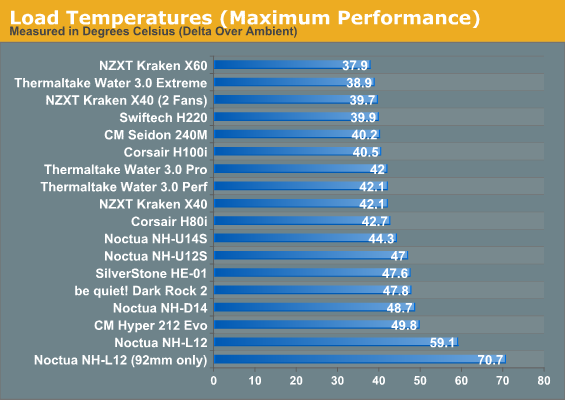
Under those circumstances, the Water 3.0 Extreme comes out looking a lot better. Of the closed loop coolers, it really continues to be between the NZXT Kraken X60 (280mm), Swiftech H220 (240mm), and Water 3.0 Extreme (240mm) for giving the widest latitude of performance and acoustics.
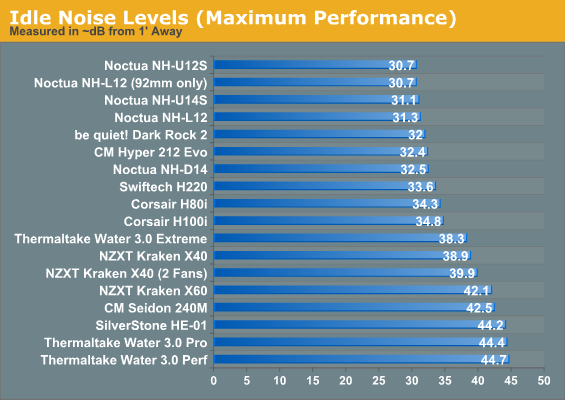
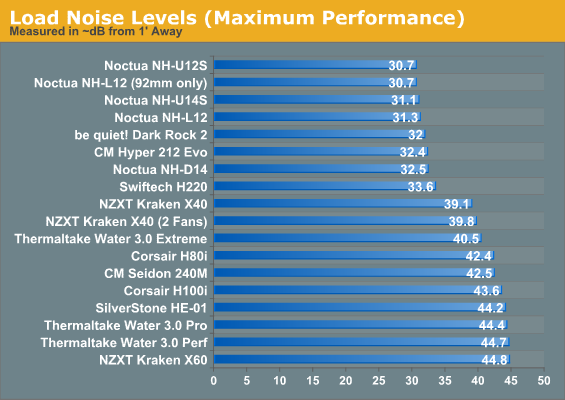
You'll pay dearly for that performance in terms of acoustics, but the 40.5dB of the Water 3.0 Extreme is still nowhere near as nasty as the 120mm Water 3.0 kits get.
Conclusions: Narrowing Down the Competition
Going through testing, it became increasingly clear to me what the Thermaltake Water 3.0 kits were, how to evaluate them, and ultimately which ones to recommend. We're dealing with fairly bone stock Asetek coolers, and that's not necessarily a bad thing. I've had a decent enough amount of experience with Asetek's closed loop coolers in the past that I'm not unhappy to see them, and the Arctic Cooling Accelero Hybrid even uses the thinner 120mm cooler to cool the GPU. It works admirably.
.jpg)
The entry-level Thermaltake Water 3.0 Performer and its thicker sibling the Water 3.0 Pro both force me to come to one unfortunately inescapable conclusion: the fans Thermaltake is using aren't very good. Put two of them in a row and suddenly there are vibration issues, harmonic issues, and even a little bit of buzzing. These fans desperately need the control the Water 3.0 Extreme offers. That the MSRP Thermaltake is asking for these two is higher than the competition and it's pretty clear to me most users would benefit from skipping them.
.jpg)
The Water 3.0 Extreme turns out to be the good egg in this bunch. While I remain unimpressed by the fans included, it's able to offer a more balanced performance and I can more easily conceive of a situation in which I would recommend it. If you can't afford the Swiftech H220, and you don't have space for the NZXT Kraken X60, the Water 3.0 Extreme will be the next best thing. The fan control software will give you fine-grained control of both thermals and acoustics and perhaps most importantly keeps the questionable 120mm fans from going off the rails.
While I still remain fairly bullish on closed loop coolers, there are increasingly only isolated cases in which I would recommend going with a 140mm or smaller radiator. If that's the scale you're operating at, you'll do just as well with Noctua's NH-U14S air cooler. If you do decide to go big, the Water 3.0 Extreme offers a decent enough performance profile but long term I'd probably consider replacing the fans, which could bring it within striking distance of the superior Swiftech H220. The NZXT Kraken X60 (or alternatively the Corsair H110) may prove to be the most ideal, but if you're on a budget and have the space to mount it, the Water 3.0 Extreme is the way to go.

_thumb.jpg)
_thumb.jpg)
_thumb.jpg)
_thumb.jpg)
_thumb.jpg)
_thumb.jpg)






